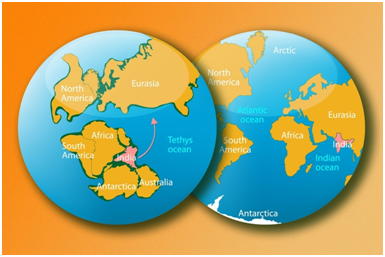Geography
Indian Monsoon Resembled Australian Monsoon
- 07 May 2021
- 5 min read
Why in News
According to a recent study based on fossil leaves, Indian monsoon 25 million years ago resembled present day Australia’s.
- Understanding the past dynamics of Indian monsoon will help in climate modelling for future monsoon prediction.
Key Points
- About the Study:
- The morphological characters of fossil leaves from different geological ages collected from Deccan Volcanic Province, East Garo Hills of Meghalaya, Gurha mine in Rajasthan and Makum Coalfield in Assam were analysed.
- Plant leaf morphological characters such as apex, base and shape are ecologically tuned with the prevailing climatic conditions to adapt for all the seasons throughout the year.
- The results indicated that the fossil leaves from India were adapted to an Australian type of monsoon and not the current Indian monsoon system during its voyage.
- After India separated from Gondwana, its 9000 km northward voyage from the Southern Hemisphere to its modern position joined with Eurasia took 160 million years.
- The reconstructed temperature data show that the climate was warm (tropical to subtropical) at all the studied fossil sites with temperatures varying from 16.3–21.3 degrees C.
- All the fossil sites experienced high rainfall, which varied from 191.6 cm to 232 cm.
- The morphological characters of fossil leaves from different geological ages collected from Deccan Volcanic Province, East Garo Hills of Meghalaya, Gurha mine in Rajasthan and Makum Coalfield in Assam were analysed.
- Separation of India from Gondwana:
- More than 140 million years ago, India was a part of the supercontinent called Gondwana.
- The Gondwana was composed of modern South America, Africa, Antarctica, and Australia.
- Tethys Ocean - an immense body of water separated Gondwana from Eurasia.
- When this supercontinent split up, a tectonic plate composed of India and modern Madagascar started to drift away.
- Then, India split from Madagascar and drifted north-eastward with a velocity of about 20 cm/year.
- The continent collided with Eurasia about 50 million years ago, giving rise to the Himalayas.
- Nowadays, India is still moving in the same direction but with a lower velocity of about 4 cm/year, due to the resistance of the Eurasian plate.
- More than 140 million years ago, India was a part of the supercontinent called Gondwana.
Indian Monsoon
- The climate of India is described as the ‘monsoon’ type. In Asia, this type of climate is found mainly in the south and the southeast.
- Out of a total of 4 seasonal divisions of India, monsoon occupies 2 divisions, namely,
- The southwest monsoon season - Rainfall received from the southwest monsoons is seasonal in character, which occurs between June and September.
- The retreating monsoon season - The months of October and November are known for retreating monsoons.
- Factors Influencing Southwest Monsoon Formation:
- The differential heating and cooling of land and water creates a low pressure on the landmass of India while the seas around experience comparatively high pressure.
- The shift of the position of Inter Tropical Convergence Zone (ITCZ) in summer, over the Ganga plain (this is the equatorial trough normally positioned about 5°N of the equator. It is also known as the monsoon-trough during the monsoon season).
- The presence of the high-pressure area, east of Madagascar, approximately at 20°S over the Indian Ocean. The intensity and position of this high-pressure area affect the Indian Monsoon.
- The Tibetan plateau gets intensely heated during summer, which results in strong vertical air currents and the formation of low pressure over the plateau at about 9 km above sea level.
- The movement of the westerly jet stream to the north of the Himalayas and the presence of the tropical easterly jet stream over the Indian peninsula during summer.
- Tropical Easterly Jet (African Easterly Jet).
- El Nino/Southern Oscillation (SO): Normally when the tropical eastern south Pacific Ocean experiences high pressure, the tropical eastern Indian Ocean experiences low pressure. But in certain years, there is a reversal in the pressure conditions and the eastern Pacific has lower pressure in comparison to the eastern Indian Ocean. This periodic change in pressure conditions is known as the SO.






-min.jpg)